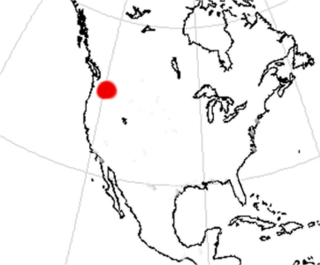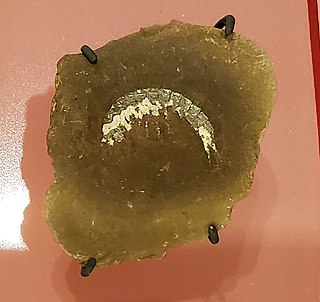
Podocnemididae is a family of pleurodire (side-necked) turtles, once widely distributed. Most of its 41 genera and 57 species are now extinct. Seven of its eight surviving species are native to South America: the genus Peltocephalus, with two species, only one of which is extant ; and the genus Podocnemis, with six living species of South American side-necked river turtles and four extinct. There is also one genus native to Madagascar: Erymnochelys, the Madagascan big-headed turtle, whose single species E. madagascariensis.

Melanosuchus is a genus of caiman. The genus is most commonly referred to as the "Black Caimans". The black caiman of South America is the sole extant (living) species, and is the largest living member of the subfamily Caimaninae, as well as the entire alligator family Alligatoridae.

Crosbysaurus is a genus of extinct archosauromorph that lived in the Late Triassic of Arizona, New Mexico, North Carolina, Texas, and Utah. It is known from the Chinle Formation and Dockum Group rock units from the southwestern United States. The type species is C. harrisae, and the only known material includes teeth. 11 specimens are known, each including a single tooth.

Orycteocetus is an extinct genus of sperm whale from the Miocene of the northern Atlantic Ocean.

Rhizocyon is an early member of the subfamily Borophaginae, an extinct subgroup of canids that were endemic to western North America during the Oligocene epoch, living from ~31—24.5 Ma., existing for approximately 6.5 million years.

Alligatorinae is a subfamily within the family Alligatoridae that contains the alligators and their closest extinct relatives, and is the sister taxon to Caimaninae. Many genera in Alligatorinae are described, but only the genus Alligator is still living, with the remaining genera extinct.
Eocaiman is an extinct genus of caiman containing species living from the Early Paleocene to Miocene in what is now Argentina, Itaboraí Formation of Brazil and Colombia. Eocaiman contains three described species: E. cavernensis, E. palaeocenicus, and E. itaboraiensis, and is typically recovered as one of the more basal members of Caimaninae. Notocaiman was synonymized with Eocaiman paleocenicus in 2022.

Dasyleptus is an extinct genus of wingless insects in the order Archaeognatha, and the only member of the family Dasyleptidae. They resembled their modern relatives and had a single lengthy filament projecting from the end of the abdomen. They also had a pair of leg-like cerci and some non-ambulatory abdominal appendages. The largest specimens reached 30 millimetres (1.2 in) or more, not counting the length of the filament. Dasyleptus was formerly placed in its own extinct order, Monura, but this is now treated as a suborder of Archaeognatha.

Brachychampsa is an extinct genus of alligatorid, possibly a basal caiman. Specimens have been reported from New Mexico, Colorado, Wyoming, Montana, North and South Dakota, New Jersey, and Saskatchewan, though only those from Montana, Utah, and New Mexico are based on material sufficient to justify the referral. Some specimens have been reported from the Campanian-aged deposits of Central Asia, although the species status is indeterminate for these fossils. The genus first appeared during the late Campanian stage of the Late Cretaceous and became extinct during the late Maastrichtian stage of the Cretaceous. Brachychampsa is distinguished by an enlarged fifth maxillary tooth in the upper jaw.
Dollosuchoides, colloquially known as the Crocodile of Maransart, is an extinct monospecific genus of gavialoid crocodilian, traditionally regarded as a member of the subfamily Tomistominae. Fossils have been found in the Brussel Formation of Maransart, Belgium and date back to the middle Eocene.

Crocodyliformes is a clade of crurotarsan archosaurs, the group often traditionally referred to as "crocodilians". They are the first members of Crocodylomorpha to possess many of the features that define later relatives. They are the only pseudosuchians to survive the K-Pg extinction event.

"Crocodylus" affinis is an extinct species of crocodyloid from the Eocene of Wyoming. Fossils were first described from the Bridger Formation by American paleontologist Othniel Charles Marsh in 1871. Marsh described the species, along with every other species of crocodyloid in the Bridger Formation, under the genus Crocodylus. The known specimen of "Crocodylus" affinis is a skull found at Grizzly Buttes, Wyoming, measuring 13 inches in length on the upper surface. Recent phylogenetic studies of crocodyloids show that "C." affinis is not a species of Crocodylus, but a genus has not yet been erected to include the species. Other Bridger species such as Crocodylus clavis and Brachyuranochampsa zangerli have been synonymized with "C." affinis.

"Crocodylus" acer is an extinct species of crocodyloid from the Eocene of Utah. A single well preserved skull was described by paleontologist Edward Drinker Cope in 1882 and remains the only known fossil of the species. It was found from the Wasatchian-age Green River Formation. "C." acer had a long, narrow snout and a low, flattened skull.

Carbonemys cofrinii is an extinct giant podocnemidid turtle known from the Middle Paleocene Cerrejón Formation of the Cesar-Ranchería Basin in northeastern Colombia. The formation is dated at around 60 to 57 million years ago, starting at about five million years after the KT extinction event.
Tomistoma cairense is an extinct species of gavialoid crocodilian from the Lutetian stage of the Eocene era. It lived in North East Africa, especially Egypt. Remains of T. cairense have been found in the Mokattam Formation, in Mokattam, Egypt. Tomistoma cairense did not have a Maxilla process within their lacrimal gland, whereas all extant (living) crocodilians do.
The Micropholidae are an extinct family of dissorophoid temnospondyls known from Late Carboniferous to Early Triassic strata in the United States and South Africa.
Australopristis is an extinct genus of sclerorhynchoid fish from the late Cretaceous epoch. Its name is derived from the Latin for "southern" and the Greek for "saw". It is known from a single species, A. wiffeni named for the late prominent fossil hunter Joan Wiffen. This species is currently known only from rostral teeth found at Mangahouanga stream and East Wing, Haumuri bluff, New Zealand. Its rostral teeth possess a smooth root which makes it unique among sclerorhynchoids. Rostral teeth appear to vary in morphology according to position and ontogenetic stage. Unlike the related Onchopristis and Atlanticopristis, it lives in a marine rather than fluvial environment and likely preferred cooler waters.
Kranosaura is an extinct genus of archosauriform reptile from the Late Triassic Upper Maleri Formation of India. It contains a single species, K. kuttyi.
Mcdonaldocnus is an extinct genus of nothrotheriid ground sloths that lived during the Middle Miocene and Early Pliocene of what is now Bolivia and Argentina. It was originally placed in the genus Xyophorus but was subsequently recognized as a distinct genus by Gaudin and colleagues in 2022. The authors reassigned the material of "Xyophorus" bondesioi, Xyophorusvillarroeli and Xyophorus sp. to Mcdonaldocnus. Fossils of Mcdonaldocnus have been found in the Cerro Azul Formation of Argentina.
Pristis amblodon is an extinct species of sawfish within the family Pristidae. It currently has two occurrences originating from New Jersey in both the Eocene and Miocene epoch. It was a nektobenthic species that lived in marine waters.











